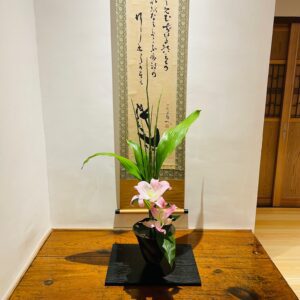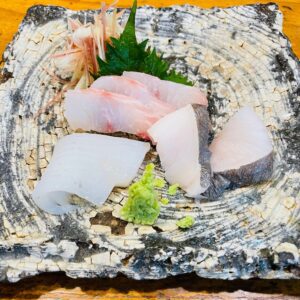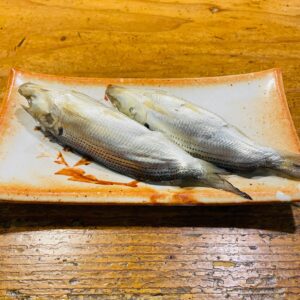May itinerary in Japan Day 2 (Kumamoto Meal edition)
(Wednesday, May 18)
Table of contents
1. Hitoyoshi Ryokan
Breakfast on May 18th was served at the accommodation “Hitoyoshi Ryokan“. I love breakfast at hot spring inns. Even though it’s breakfast, it’s great to be able to eat many kinds of side dishes. Also, the color of the small bowl containing many kinds of side dishes is beautiful.

The breakfast at Hitoyoshi Ryokan was one of the best breakfasts I have ever had at a hot spring inn. I ate dried sweetfish for the first time. The Kuma River, which runs beside Hitoyoshi Ryokan, is famous for catching delicious sweetfish. The opening date for sweetfish fishing is June 1, so it’s a pity that I could only eat dried sweetfish this time. Next time, I wanted to revisit Hitoyoshi during the sweetfish fishing season.

When I left the breakfast venue of “Hitoyoshi Ryokan”, beautiful flowers were laid. I was happy with the fresh flowers that matched the atmosphere of “Hitoyoshi Ryokan”.

“Hitoyoshi Ryokan” is a wonderful ryokan, and the services of the landlady and female employees were also pleasant. The complaint was that the male employee was unfriendly. It may be unavoidable because of the “Higo Mokkosu” temperament of “stubborn and uncompromising masculine nature”. However, the service of the female staff is the best, so I felt the poor service of the male staff was terrible. It may be better to think of this as a good thing about local travel.
2. Yorifuji
Arrived in Yatsushiro City and had lunch at “Yorifuji” in front of Yatsushiro Station. “Yorifuji” is famous for offering the ekiben “Ayuya Sandai”. “Ayuya Sandai” is a very popular ekiben that won the first place in the popular ekiben ranking in Kyushu for three consecutive years. This ekiben is a bento box with a whole Kanro-ni (boiled in a syrup or grilled) of Kuma River’s natural sweetfish that is softly simmered to the bones on top of rice cooked with the soup stock of grilled sweetfish.

I ate “Kanro-ni / Grilled set meal” (Yen 2,600) and “Ko-Uruka” (Yen 600) at “Yorifuji”. At the ekiben “Ayuya Sandai”, you have to choose either Kanro-ni or grilled sweetfish, but at “Yorifuji” you can eat both. Kanro-ni of sweetfish is simmered softly to the bone, so you can eat whole sweetfish.
In addition, you can enjoy the same taste as raw sweetfish by thawing and grilling frozen sweetfish caught in the previous season. Rice cooked with the soup stock of sweetfish has a gentle seasoning and goes very well with Kanro-ni. Kanro-ni and grilled of sweetfish that I ate at “Yorifuji” was by far the most delicious sweetfish in my life. It was delicious that I wanted to revisit Yatsushiro just to go to “Yorifuji”.


“Ko-Uruka” is fermented food made from sweetfish egg and soft roe (milt). It’s salty, but it’s not so salty compared to the fermented squid. I ate “Ko-Uruka” for the first time, and it was a delicacy with an exquisite taste. This “Ko-Uruka” has become a delicacy that I definitely want to eat when I return to “Yorifuji”. The next time I eat it, it’s a delicacy I’ll want to eat with sake.

3. Nishiki sushi
I had dinner at “Nishiki Sushi” next to “Kappo Ryokan Shoukinkan” where I stayed. “Nishiki Sushi” is a well-known restaurant selected by the Michelin Guide Bib Gourmand. I was very satisfied with the fresh seafood, mainly local fish, at “Nishiki Sushi”. May 18th was a perfect delicious meal day with everything from breakfast to dinner. I think I’ve been able to eat the perfect delicious meal for all three meals only a few times in my life. It was a really happy day.
“Kappo Ryokan Shoukinkan” is run by the son of the master of “Nishiki Sushi”. Even if we drink delicious sake at “Nishiki Sushi” and get drunk, we can rest assured that we only sleep at the “Shoukinkan” next door. It’s also nice to feel comfortable that we don’t have to move after drinking alcohol.
I first ordered a “sashimi platter” of local fish at “Nishiki Sushi”. The contents were spotted Knifejaw, butterfish, and bigfin reef squid. The season for spotted Knifejaw in Kumamoto is early summer. It is delicious in earnest from May and June. Butterfish is also in early summer. The season for bigfin reef squid in Kumamoto is April-June. All the fish and shellfish included in the “sashimi platter” were seasonal and were very delicious.

Next, I ate the boiled “Shaku” recommended by the master. “Shaku” is officially called Japanese mud shrimp. I thought it was a mantis shrimp because it has a similar shape, but it is a completely different kind of crustacean. The best season is from around May. “Shaku” is a fish and shellfish that makes Kumamoto people feel early summer. When boiled, it turns red and the shell is soft, so we can eat it all as it is. I ate it for the first time and it was very delicious.
“Shaku’s Tempura” is also listed as a local dish in Kumamoto Prefecture in “Our Regional Cuisines” by the Ministry of Agriculture, Forestry and Fisheries. “Shaku fishing” is a method of putting a brush in the burrow that appeared after the tide has subsided and catching the Shaku that came out to the entrance of the hole one by one. The master and the okami (landladies) of “Nishiki Sushi” taught me. There is an interesting way of fishing.

Next to “Shaku”, I had boiled Japanese squid (Loliolus japonica) and Little cuttlefish (Bottle-tailed cuttlefish). Both are small squids. In particular, Little cuttlefish (on the left side of the photo) is a very cute squid with a size of about 3-4 cm. Japanese squid is a squid that can be caught nationwide, but Little cuttlefish is a rare squid that is rarely distributed. The season is spring, so I was able to eat it at the last minute. Both were delicious squids.

Next, I ate the “Whole Konoshiro (dotted gizzard shad) Sushi” that I was looking for. “Whole Konoshiro Sushi” is also listed as a local dish of Kumamoto prefecture in “Our Regional Cuisines” by the Ministry of Agriculture, Forestry and Fisheries. “Whole Konoshiro Sushi” is especially eaten in the coastal areas of the Yashiro Sea, Amakusa Nada, and the Ariake Sea. The first time I ate “Whole Konoshiro Sushi”, the effect of vinegar was exquisite and it was very delicious. The season for dotted gizzard shad is from autumn to winter, so I definitely want to eat “Whole Konoshiro Sushi” during the season.
Kumamoto Prefecture is the second largest catch of dotted gizzard shad in Japan. The first place is Chiba prefecture (2020). In particular, in Uki City, where the catch of dotted gizzard shad is high, they have created a character called “Konoshiro Bucho (Manager)” to appeal to the gourmet highway called “Uki-Uki Konoshiro Highway”. However, Instagram’s “Konoshiro Bucho” has only 188 followers (as of May 23). At the very least, why don’t they follow all the people from the city hall of Uki City?

Finally, I had “Matcha Nigirizushi (sushi shaped by hand)” and “Battera (mackerel sushi of Osaka)”. “Matcha Nigirizushi” is a “local fish sushi” that is named after “Matcha” in Matsuai where “Nishiki sushi” is located. “Matcha Nigirizushi” contained top shell (rock shell), false fusus, hairtail (cutlass fish), flounder, horse mackerel, conger eel, and Japanese tiger prawn.

Top shell (rock shell) is in season from February to May. False fusus is in season in spring. It can only be caught in very limited places, mainly in Kumamoto prefecture. Hairtail is in season from summer to autumn. Hairtail fishing is popular in Amakusa, which is a little over 30 minutes by car from Matsuai. Hairtail is selected as one of the 17 types of local fish “Kumamoto Shiki no Sakana” selected by Kumamoto Prefecture. Similarly, flounder, horse mackerel, and Japanese tiger prawn are also selected as “Kumamoto Shiki no Sakana”.

Both “Matcha Nigirizushi” and “Battera” were delicious, and I was impressed and thankful for each one. “Nishiki Sushi” was the best sushi restaurant. Thanks for dinner.
Note: The departure / arrival times, fares, admission fees of transportation, meal prices, etc. listed in the text are as of the time of writing the BLOG. Please check for yourself when you go on a trip as it may change in the future.